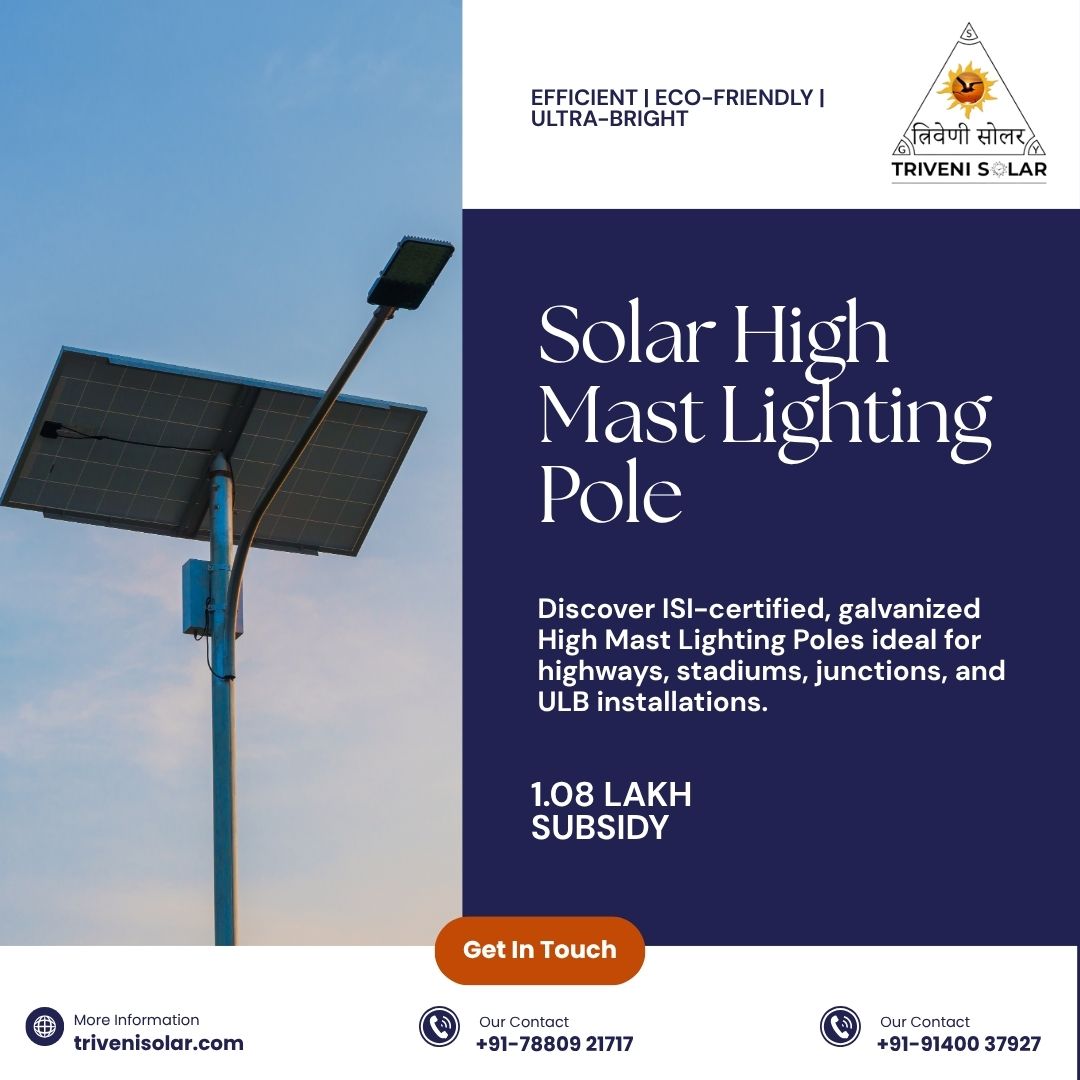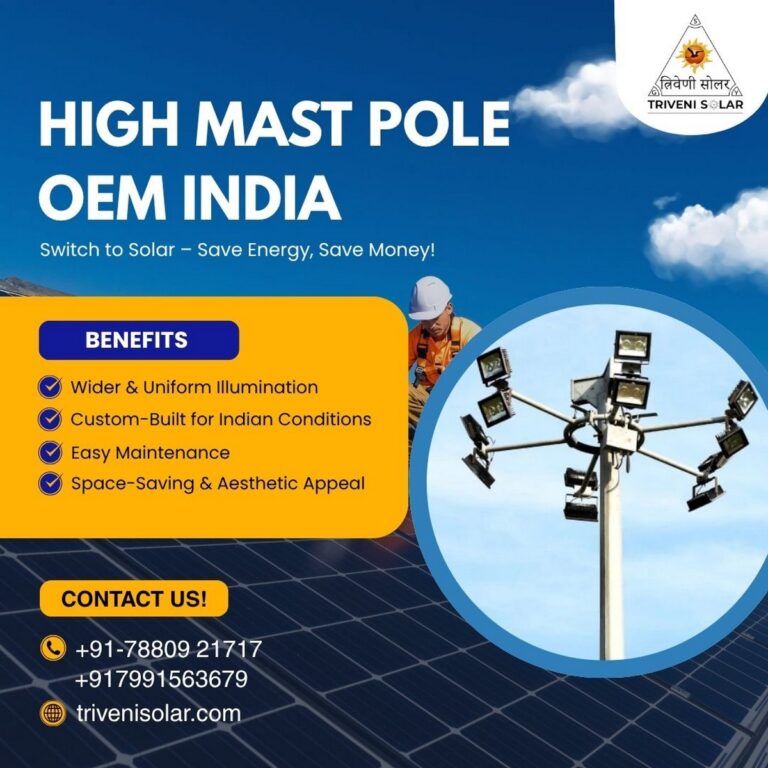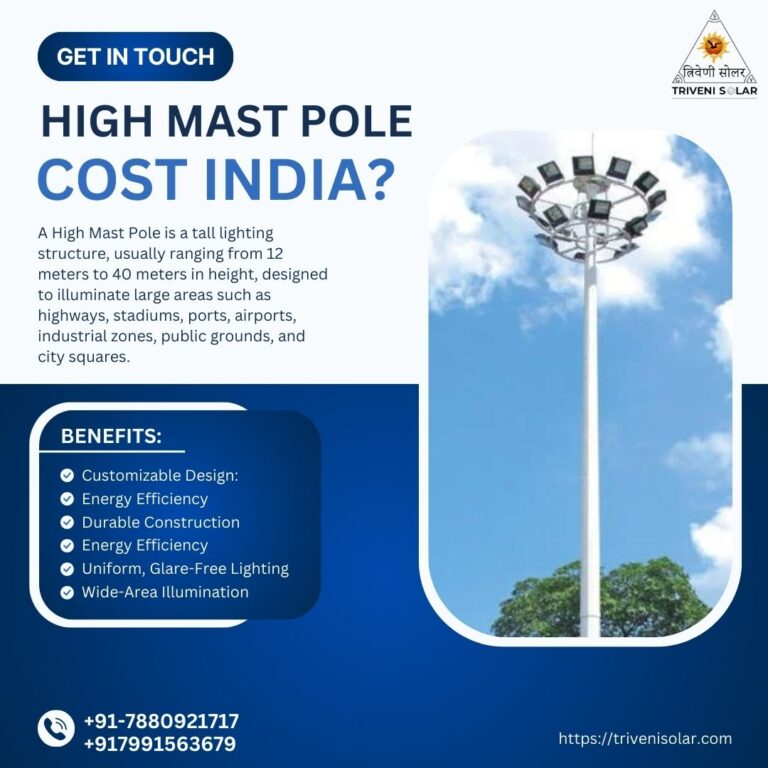When a single pole needs to light an entire junction, stadium, port, or highway interchange, regular streetlights aren’t enough. That’s where high mast pole lighting comes in—poles that range from 12m to over 40m and carry clusters of high-power luminaires to light very large areas. For municipal engineers, procurement managers, and industrial yard operators in India, choosing the right high mast lighting system means balancing safety, standards, energy costs, and lifetime maintenance. This guide walks you through everything you need to know—from IS standards and design checks to lifecycle ROI and a tender-ready checklist you can use today.
What is high mast pole lighting —and where is it used?
High mast lighting is a centralized lighting solution: multiple powerful luminaires cluster at the top of a single, tall pole to provide uniform illumination over a wide area. Typical applications include stadiums, ports and freight yards, highway interchanges, large parking lots, and airport aprons. Modern high mast systems use LED luminaires and lowering devices (winch systems) so maintenance can be done safely from the ground.
Typical sizes & configurations
- Heights commonly sold in India: 12m, 16m, 20m, 25m, 30m — and up to 60m for industrial/specialized installations.
- Crowns: 4–16 luminaires arranged on a ring or crossarm.
- Power: depends on the luminaire; many modern high mast installations use high-output LED modules delivering tens of thousands of lumens each.
Why choose High Mast Pole Lighting? Benefits for cities and industries
- Large coverage with fewer poles: saves foundation work and simplifies maintenance.
- Improved safety & CCTV visibility: fewer blind spots and better uniformly distributed lux levels (important for traffic safety and security).
- Reduced lifecycle costs (LED): modern LED high mast fixtures cut energy consumption and reduce lamp replacement cycles compared to HPS or metal halide. Several suppliers advertise energy savings up to ~60%+ when switching to LED high mast systems.
- Centralized maintenance: lowering devices means luminaires can be lowered for service instead of expensive lifts.
Types of high mast systems
Fixed (non-lowering)—cheaper initially, less convenient to service.
Telescopic / Lowering (winch) systems—a luminaire ring is lowered for maintenance using winches (manual or motorized). These are preferred where traffic disruption must be minimized.
Lowering device types
- External winch lowering systems (easier retrofits).
- Internal winch systems (neater, protected winch but higher initial cost).
When procuring, specify winch load rating, safety brakes, cable specs, and maintenance intervals.
Engineering essentials: standards (IS 875) & wind loads
Designers must account for the dynamic wind response of tall, slender poles. In India, wind design guidance referenced in tenders commonly points to IS 875 (Part 3) for wind loads; major procurement documents (GeM, PSU tech specs) also require compliance with IS/ISO manufacturing and wind-resistance testing. For example, several Indian tender specs require pole performance under a 180 km/h (3-second gust) design or higher for coastal locations, plus proof of structural calculations and foundation drawings.
What to ask for in bids
- Structural calculations and CAD drawings (baseplate & anchor bolt details).
- Dynamic response and resonant frequency info (to avoid vortex shedding).
- Certification: material specs (IS 2062 / Q235 / Q345), galvanization thickness (µm), ISO 9001 manufacturing controls.
LED vs HPS vs High Mast Pole Lighting — lifecycle cost & ROI (illustrative example)
High Mast Pole Lighting Switching to LED (or LED+solar hybrid) is now standard for new high mast installations. LEDs offer longer life and better directional control, and modern LED luminaires come with IP67 protection and 100,000-hour rated lifetimes in some products. Constellation Lighting
Illustrative annual energy example (sample calculation)
(Example to help procurement teams compare energy spend—replace tariff with local rates.)
- Configuration A: 4 × 1000W HPS (total 4.0 kW)
- Configuration B: 4 × 400W LED (total 1.6 kW)
- Operation: 12 hours/day → 4,380 hours/year.
Using ₹8/kWh (example tariff):
- HPS energy/year = 4.0 kW × 4,380 h = 17,520 kWh → ₹140,160/year.
- LED energy/year = 1.6 kW × 4,380 h = 7,008 kWh → ₹56,064/year.
- Annual energy savings: ₹84,096/year (example).
(Adjust tariff to your local commercial rate; our downloadable ROI spreadsheet embeds a tariff input field.) (calculation example)
Choosing the right supplier: tender checklist (India)
When preparing or evaluating tenders, ask for:
- Technical pack: material specs, foundation drawings, BOM, luminaire photometry (IES files), wind load calcs.
- Standards & testing proof: IS/ISO certificates, galvanization thickness test reports, and wind tunnel/structural test reports where applicable. Utkarsh India
- Warranty & service: luminaire L70 warranty, winch warranty, estimated maintenance schedule.
- Case studies: local installations and references (municipal projects are strongest). News coverage of city rollouts is a signal of procurement cycles.
- Post-sale support: spares availability, AMC options, and training on lowering systems.
Installation & maintenance: best practices
- Foundation: follow the manufacturer’s baseplate & M30/M40 concrete design; ensure anchor bolt torque and embedment match drawings.
- Lowering systems: periodic inspection of wire ropes, winch brakes, and electrical control (for motorized).
- Annual luminaire checks: clean optics, verify torque on fasteners, and check earthing.
Case studies & proof points (India)
- Municipalities across India are actively installing/retrofitting high mast LED and solar high-mast systems (recent city rollouts reported in 2024–2025), signaling procurement opportunities. Municipal news items show projects for parks, junctions, and cremation grounds—a clear sign of demand in the civic space.
Triveni Solar note: Triveni Solar’s high mast poles (12m–30m) are manufactured from Q235/Q345 grade steel, hot-dip galvanized, and supplied with winch lowering systems and foundation drawings (product listing). If you want, request our tender pack, which includes AutoCAD baseplate drawings and a ready-to-use technical spec.
FAQ (short list—enable schema)
- What height is a high mast? Typically ≥12m; many municipal systems use 20–30m. trivenisolar.com
- Which standards apply in India? IS 875 (Part 3) for wind loads is commonly referenced; tender specs often ask for ISO 9001 manufacturing and BIS/IS compliance where applicable. Internet Archive MKP
- Can high masts be solar? Yes—solar-assisted or hybrid systems are being deployed for parks and remote sites (some municipal projects use solar high mast).
- How long before LED pays back? Depends on the tariff and system sizing. Example above shows large energy savings; use our ROI spreadsheet to calculate project-specific payback




